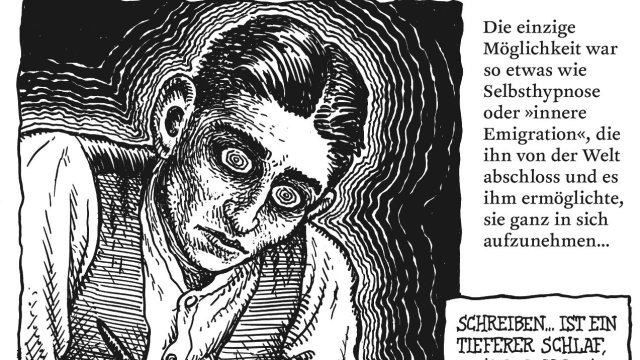Unusually well-behaved, but solid: Robert Crumb’s Kafka
Photo: Reprodukt/Robert Crumb
Kafka as a comic? That sounds “a bit like ‘Nolde from the supermarket’. Unfortunately. Because Peter Kuper proves that the ‘Mickey Mouse medium’ can handle literature appropriately” – that was the verdict of the “Taz” in 1997 when Kupfer’s impressive Kafka comic “Gibs auf!” was published. In it, Kuper reduced Kafka’s short stories to a few pages and succinct lines, developing strong visual power in the process; The book is now only available second-hand. 25 years later, no one would write from a “Mickey Mouse medium” and no one would have to justify processing literature as a picture story anymore.
That’s why the aesthetic despondency of the new Kafka comics, which appear on the 100th anniversary of his death (June 3rd), is surprising. Only one of four publications dares to appropriate this writer in a graphically original way, as Kuper did: “Like a Dog” by Danijel Žeželj. Perhaps other artists find Kafka’s texts too sacred for interventions and montages? But they follow Kuper’s approach of preferring black and white drawings to represent Kafka’s fragmentary work with its absurd, surreal events and dark dreams.
“Kafka” by the legendary illustrator and author Robert Crumb, who worked together with the crime writer David Zane Mairowitz to create a solid biography, is an unusually well-behaved read. It reflects the content of Kafka’s life and selected works. You learn about his father’s conflict and Kafka’s struggle with his own physicality. The conflict between Judaism, Czechness and Germanness and the associated attributions from others are just as much a topic as Kafka and women. It turns out to be very text-heavy; the drawings in the restless, realistic Crumb style seem like mere illustrations placed next to them. A lot can be learned in detail in this comic. But it seems a bit staid, given the fact that it comes from a pioneer of US hippie comic culture. But that could also be because the original was published in 1993 and the German translation in 1995 by Zwei Thousand One. Reprodukt-Verlag is now releasing this album in an extremely affordable paperback edition.
“Verwandelt” by Thomas Dahms and Alexander Pavlenko is also a solid biography that suffers from text overload. Kafka’s stages in life are explored, his amorous relationships form a focus, as his life and loves are told from the perspective of his last partner, Dora Diamant. With details such as Kafka’s actual involvement in an asbestos factory, the book is up to date biographically and is suitable as an effortless introduction to Kafka’s world. Attractive images with pretty plays of light and shadow: sometimes the graphics look like papercuts or woodcuts. In addition to these black and white effects, there are sometimes monochrome color areas, so the picture frames look like early photographs.
Nicolas Mahler calls his interpretation of Kafka “Completely Kafka” and of course nothing is complete here. Instead, Mahler picks out the most original facts and anecdotes for his quote collage and illustrates them with his well-known casual, minimalist style and his well-known black humor. This is how we learn about Kafka’s missed bestseller project, who once wanted to write cheap travel guides. And who knows that “The Return of Gregor Samsa” exists? However, it was written by another Prague author: Karl Brand, 1916. That’s funny and typical Mahler, but even this grumpy Viennese illustrator, who had already scribbled a biography of Godzilla, was afraid to take Kafka away from the monument. In this volume too, text takes precedence over images. This isn’t a disappointment, but it’s still conventional.
In contrast, “Like a Dog” by Danijel Žeželj is finally a surprise. The Croatian artist, who draws action comics for Marvel and DC and illustrations for “Harper’s”, takes up the last words from “The Trial” and follows Kafka’s original texts. The story “A Hunger Artist” serves as his main inspiration: there really used to be people who exhibited themselves at fairs and earned their money by not eating in public. Žeželj creates his own world from this, a cosmos of circus and crowds, wild animals and marching armies. The arrangements into which Žeželj puts his realistic drawings together are expressionistically explosive, giving them a touch of stencil street art, graffiti made with stencils that almost appear photographic.
There is something to discover on every page and you can find starting points for your own associations. Isn’t Rilke’s panther roaring behind a thousand bars there, or is Alex and his brutal droogs from “Clockwork Orange” sneaking around here? This comic is a visual feast, independent and strange. This makes it the closest to Kafka’s work because it breaks away from his literature much more than the other comics and changes the direction, so to speak, in order to find something new in it even after 100 years of interpreting and re-interpreting it.
Robert Crumb/David Zane Mairowitz: Kafka. A.d. America. English by Ursula Grützmacher-Tabori. Hand lettering by Marianne Nuß. Reproduction, 176 pages, br., 9 €.
Alexander Pavlenko/Thomas Dahms: Transformed. Franz Kafka – life, love, literature. Knesebeck, 128 pages, hardcover, €24.
Mahler: Completely Kafka. Suhrkamp. 127 p., hardcover, €18.
Danijel Žeželj: Wie ein Hund. Avant, 104 S., no., €22.
Become a member of the nd.Genossenschaft!

Since January 1, 2022, the »nd« will be published as an independent left-wing newspaper owned by the staff and readers. Be there and support media diversity and visible left-wing positions as a cooperative member. Fill out the membership form now.
More information on www.dasnd.de/genossenschaft
